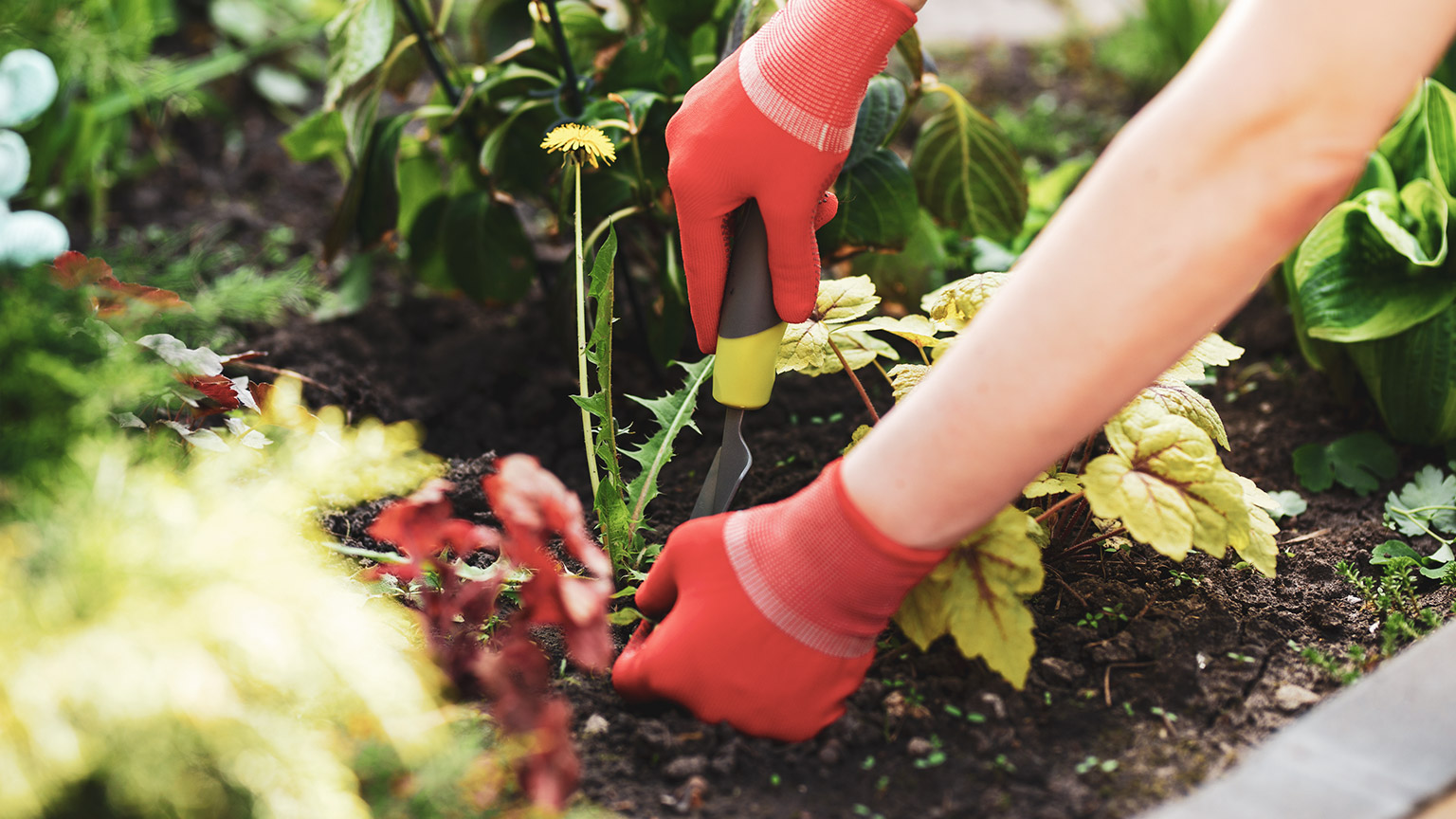In this section we share some ideas about how to identify and control some of the most common pests and diseases of fruit and vegetable crops, and how to control weeds.
Why we control pests, diseases, and weeds
Pests, diseases, and weeds can all impact the amount and size of the fruit and vegetables we grow.
| Problem | Impact on the garden |
|---|---|
| Pests | A pest can eat right through a plant's yield of fruit or veg. We may choose to share some of our crops with these small and medium-sized animals, but we’ll need to take steps to ensure we don’t give away everything we’ve grown. |
| Diseases | They can seriously reduce how much of our crops are edible. |
| Weeds | Compete with our desirable plants for light, water, and nutrients, so if left uncontrolled, these problems can easily reduce the yield of our crops and can even cause our plants to die. |
In this section, we look at a few of the most common pests of fruit and vegetable crops in Aotearoa, and how to identify and control them. The list that follows is in rough order of smallest to largest.
Thrips (order: Thysanoptera)
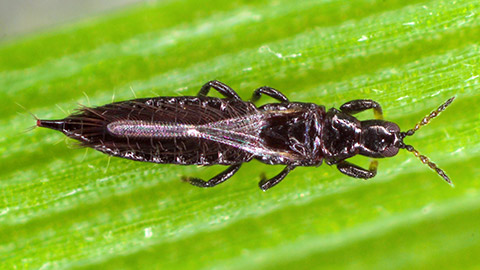
Thrips are tiny (about 1 mm long or less), slender insects with fringed wings and unique asymmetrical mouthparts. There are about 6,000 known species. A small number of these are serious pests to commercial crop species.
Plant Barn | Plant doctorThrip feed by puncturing the upper layer of a cell and sucking out the insides. They are also known to carry viruses that can be passed on to the plants they feed on. They feed on all types of common crops; from citrus to herbs, potatoes to stonefruit.
Because they are so small, the easiest way to identify them is by the damage they cause. On leaves the damage caused through feeding is quite obvious, causing the leaves to discolour and become silvery/grey. Flowers often brown and fall off prematurely.
Controlling Thrips
Thrips can be treated with insecticidal soap, or a range of organic or conventional insecticides, as described at the link above.
Activity – Learn more about thrips
Visit the Plant Barn article about thrips to learn more about this pest and view images of the damage they cause to plants.
When you get to the page, click the photo on the right, above the caption "Thrip damage on leaves" and progress through all of the images.
Aphids
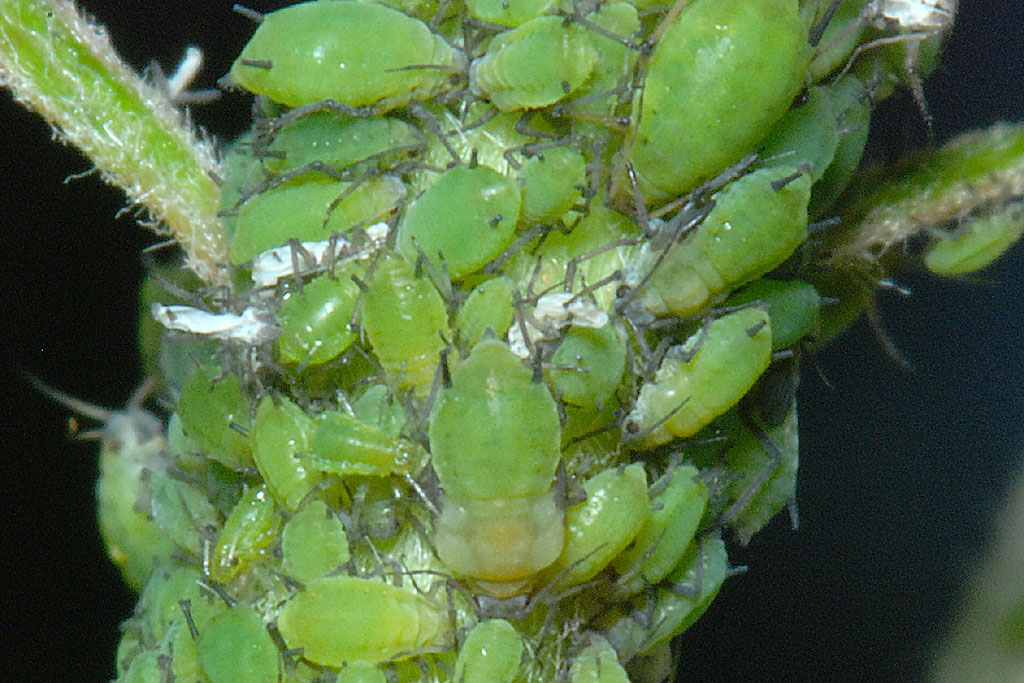
These common green aphids (Aphis pomi) are feasting on a crab apple stem. Source: Wikimedia Commons
Aphids are small sap-sucking insects. There are about 5,000 species of aphids, of which, about 400 species feed on commonly grown food and fibre crops. They cause damage by feeding on those crops, however, the main source of damage is by spreading plant viruses.
When you can let them be
Remember, not all aphids need to be controlled — only those that are causing damage to the parts of the plant that we eat, or if they negatively affect the health of the plant.
Woolly Apple Aphids
Woolly apple aphids (Eriosoma lanigerum), also called Woolly aphids, are small to medium-sized aphids, up to 2mm long, and have an elliptical shape. They are reddish brown to purple in colour, but the colour is normally hidden by the white cotton-like secretions that give them their name.
Woolly apple aphids can damage the roots of apple trees leading to a decline in health and eventual death. Control woolly apple aphids by spraying affected apple trees with lime sulphur in winter when all leaves have fallen. This will ensure that any over-wintering insects will be eradicated. If found in summer, use any of the treatment options shown below.
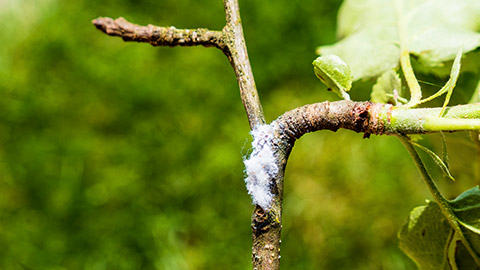
Activity – Know your aphids
Read this article about Aphids on the King's Plant page, click on the image on the right and cycle through all of the photos so you can learn what to look for when assessing your plant's health.
Controlling Aphids
- Planting nasturtiums around the garden to act as a sacrificial crop.
- Planting alliums (onion family) or marigolds (Tagetes ssp.) to repel them.
- Blasting them off plants using a jet of water from your hose nozzle every few days.
- Spaying plants with insecticidal soap.
- Spraying with organic or conventional insecticides as described on the King's Plant Doctor: Aphids webpage.
Source: King's Plant Doctor
Activity – Identifying and controlling aphids
Tomato/potato psyllid
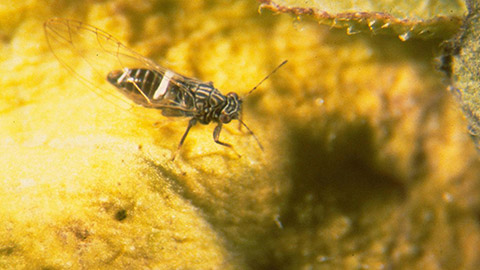
Psyllids are also sap-sucking insects. They feed by inserting their needle-like sucking parts into the plant and sucking out the sugary sap. They are most active during December and January.
Kings Plant Doctor refers to the problems, which includes Zebra Chip:
[Psyllids]... mainly affects potato and tomato. Can also affect other members of the solanaceae family (peppers, egg plants, and tamarillos) and kumara.
Psyllids inject a toxin into plants which causes discolouration to occur on the foliage, so called ‘psyllid yellowing’ and ‘purple top’, the leaf edges upturn and and start to yellow or go purple.
Zebra chip is a recently diagnosed disease of potatoes associated with psyllid infestation… [which causes the potatoes to have] discolouration, which becomes more clear during frying of chips.
Codling moth (Cydia pomonella)
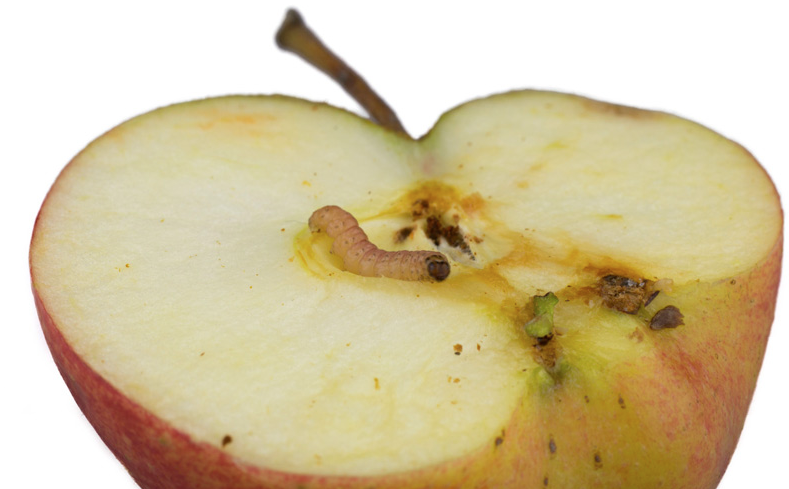
Codling moth is a moth species that lays its eggs on apples and other pipfruit species. The larvae burrow into the fruit and feed on it for about three weeks.
Again, we'll look to King's Plant Barn for a description:
King's Plant BarnThe adult moths are 1 -2 cm long, and often hard to spot as their mottled wings blend well with tree bark. The larvae overwinter within silken cocoons in the soil, in leaf litter around the base of trees, or under loose scales of bark.
Control codling moth
Watch this video, by Organic Edible Garden, to learn how to make and hang codling moth traps before the buds on your apple and pear trees ripen. Jump to the 3-minute mark if it doesn't start there automatically.
Slugs and snails

Slugs are responsible for eating both fruit and vegetables as well as the leaves of the plant.
The simplest way to rid your garden of slugs and snails is just going out at night with a torch and picking snails off your plants. Put them in a jar and dispose of them in the morning.
Another way is laying coffee grounds around your plants. Slugs and snails find it difficult to traverse coffee grounds. Coffee grounds can become quite acidic, so counter-balance that with a sprinkling of garden lime.
We'll return to the useful Organic Edible Garden video we used to show you codling moth traps, and watch the first three minutes to learn about managing snails and slugs.
Birds

Birds can be considered allies and pests. This touhou (waxeye) isn't going to leave much of this ripe persimmon for the grower to enjoy, but may leave the other untouched.
Birds are experts at getting into our fruit before we do. Many people choose a keep-some, net-some approach to sharing with the birds — where they put netting over most of their trees and leave some without netting to share those fruit with the birds.
Because birds can be devastating to an entire crop in a very short time, it's useful to learn how to net them. Cherries are irresistible to birds, and if the grower wants even one of them, they'll have to protect these small sweet fruits of summer.
Cats and dogs

Some cats and dogs make a horrible mess of freshly planted vege gardens, either by digging plants out or pooing in the garden.
Cat poo, and then the soil it comes into contact with, can be infected with a disease called toxoplasmosis. Toxoplasmosis is usually harmless but can cause serious problems if you are pregnant or have a weakened immune system.
One option to keep cats and dogs from pooing in your garden beds is to press bamboo skewers into the soil at 15-20cm spacings.
Activity – Pest Identification
In this section, we look at a few of the most common and damaging diseases of fruit and vegetable crops in Aotearoa and how to identify and control them.
These include:
Fire blight

An apple tree infected with fire blight. Source: Wikimedia Commons
Fire blight is a contagious disease affecting apples, pears, and some other members of the rose family (Rosaceae).
Fire blight is no small matter, as these quotes indicate:
Wikipedia ContributorUnder optimal conditions, it can destroy an entire orchard in a single growing season.
KiwicareFire blight is a bacterial infection which usually appears on trunks, branches, and twigs as cankers that ooze in spring. The ends of shoots will brown off, blacken and die. Dead and blackened fruit and leaves will hang on the tree throughout the season.
Controlling fire blight
- In summer or winter, remove dying and dead limbs.
- Leaf litter must be cleared away as it may harbour bacterium.
- Removing the bark (outer and inner) of the infected areas (adding 20cm around) is done to prevent infection of the trunk or major limbs.
- As a preventative measure, apply a copper fungicide spray to open blossoms on a regular basis.
Source: Kiwicare
Apple scab (Venturia inaequalis)
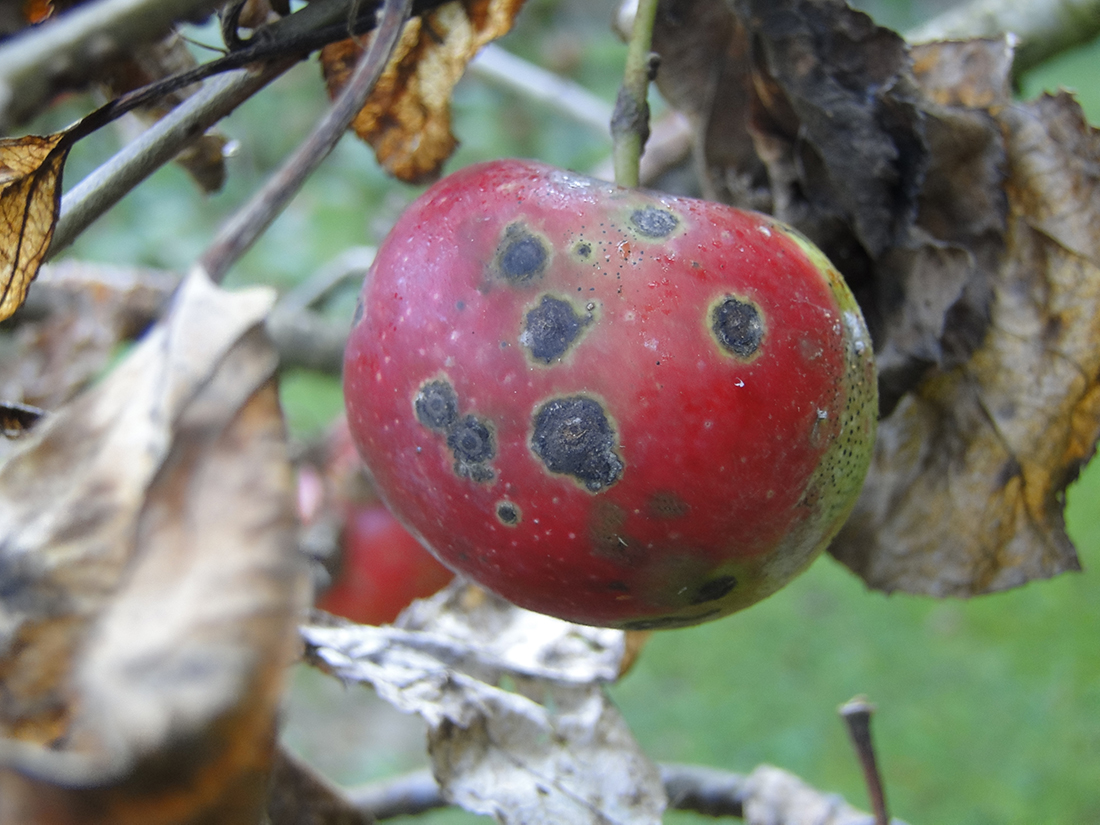
Apple scab is a disease of apple trees and fruit.
KiwicareSymptoms of apple scab, caused by Venturia inaequalis, include circular black spots on leaves and fruits. On fruits, the spots can coalesce resulting in cracks and rots.
Kiwicare continues to indicate that the disease is made worse by wet and mild weather. A similar species, Venturia pirina causes black spots on pears and is called, as you would expect, pear scab. Though one cannot spread to the other. In other words, pears will not catch it from apples and vice versa.
Controlling apple scab
They key is controlling excess or long-standing moisture on and around the tree.
- Pruning enhances air movement and allows sunlight to penetrate, speeding up leaves and fruit drying, which makes the tree less susceptible to apple scab.
- Planting new apple trees with wide spacing enhances air movement. Select scab-tolerant species when planting.
- Speed up leaf composition by applying urea to fallen leaves. Otherwise, collect the leaves and compost them.
- Apply copper fungicide when the disease first appears, and repeat at 7-to-10-day intervals up to blossom drop.
Source: Kiwicare
Brown rot (Monilinia laxa and Monilinia fructigena)
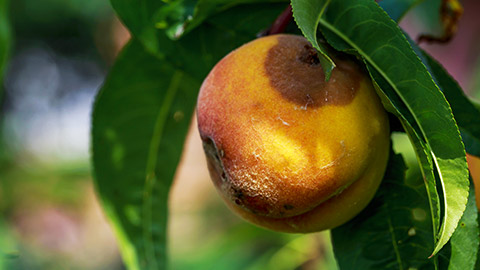
Brown rot is a fungal disease that affects fruit trees. It is caused by two pathogens: Monilinia laxa and Monilinia fructigena.
Wikepedia contributorsMonilinia laxa commonly affects stone fruit, particularly peaches and nectarines, whereas Monilinia fructigena affects apples, pears, plums, peaches and cherries.
Kings Plant BarnBrown rot enters the fruit through bruises or damaged areas. When infected, it causes fruit to fully rot within days and remain on the tree while shedding its spores until eventually becoming mummified. It is recognisable by the distinctive brown pustules that form on the fruit, which then slowly rot on the tree. If the fruit is picked in the early stage of infection some of it may still be able to be eaten.
Controlling brown rot
- Keeping trees healthy — well-watered, fertilised, and pruned to allow good light penetration and air movement.
- Thinning out fruit – clusters of fruit provide good conditions for brown rot to form so remove some fruit in cases where they are touching.
- Disposing of infected fruit as soon as they are noticed.
- Spraying infected plants with a copper fungicide as soon as infected fruit are noticed and disposed of.
- Spaying trees with copper fungicide in autumn to prevent brown rot in the coming year.
Source: Kings Plant Doctor
Leaf curl (Taphrina deformans)
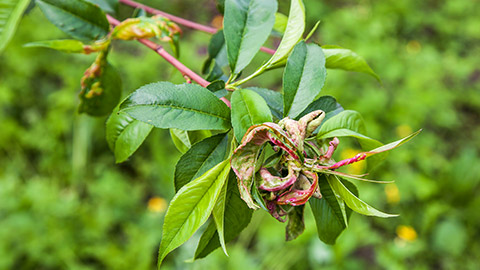
Wikipedia contributorsPeach leaf curl is a distinctive and easily noticeable fungal disease, and the severity of the symptoms depends on how early the infection has occurred. Diseased leaves can usually be identified soon after they emerge from the bud, due to their red colour and twisted shape.
KiwicareInfected young leaves become swollen, thickened and distorted. Leaves usually loose colour turning light green or reddish. Heavily infected leaves will fall. Shoots are often stunted and distorted.
Leaf curl is common in cool, wet, spring weather.
Controlling leaf curl
- Spray with copper fungicide soon after pruning, just before bud burst happens in spring.
- Alternatively, spray with vinegar solution, biological tonic or milk solution.
- More information can be found in the following two articles on the Edible Backyard website: What to do about leaf curl, Preventing and managing fungal disease.
- Control pests as described in the previous topic, e.g. insecticidal soap, to prevent them from spreading leaf curl to unaffected plants.
- Spray trees with copper fungicide in autumn to prevent leaf curl in the coming year.
Powdery mildew

These pea leaves are covered in powdery mildew. Source: Wikimedia Commons
Powdery mildew is caused by many different fungal species and is commonly found on a large range of plants, very commonly on pumpkins, cucumbers, courgettes, and dahlias.
Infected plants develop a distinct white powdery film that covers their leaves. Sometimes confused with downy mildew, it can easily be distinguished as the powdery film only forms on top of leaves and doesn’t penetrate the leaves or form on the underside.
Powdery mildew is mainly a problem when it affects plants early in their growing season, as it can significantly reduce the plants’ yield of fruit, attractiveness and length of life expectancy.
Kings Plant Barn adds:
On cucurbits (pumpkins, courgettes, etc) treatment is only necessary if they are affected badly, or affected early in the season, as some powdery mildew is inevitable towards the end of the growing season.
Controlling powdery mildew
- Keep plants healthy — well-watered, fertilised, and pruned to allow good light penetration and air movement.
- When watering, avoid wetting the leaves.
- Spray infected plants with a sulphur fungicide if it is significantly affecting the crop’s yield.
Source: Kings Plant Doctor
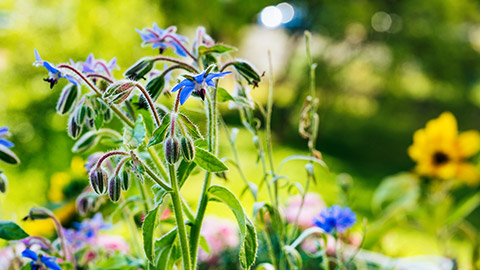
Before we talk about how to control weeds, it’s important to know what a weed is.
In botany (the study of plants):
Te AraA weed may be defined as any plant or vegetation that interferes with the objectives of farming or forestry, such as growing crops, grazing animals or cultivating forest plantations. A weed may also be defined as any plant growing where it is not wanted.
So in our garden, a plant like borage (Borago officinalis) might be a desirable plant in a garden bed with its whimsical, bee-attracting, purple flowers, but if it spreads into the lawn, we might call it a weed and try to get rid of it.
Pest plants
It should be noted that some weeds are considered noxious weeds or pest plants and may be regulated by your council.
For example, Agapanthus (Agapanthus praecox) is considered a pest plant throughout the entire Auckland region and has a status of sustained control. According to the Auckland Council, you are not allowed to grow a new plant, breed, distribute, release, or sell agapanthus in Auckland. You may only transplant one if you are moving it to a different spot on the same property.
Others plants must be actively destroyed, and their status with the council is eradication. Another example in the Auckland region is the African feather grass (Cenchrus macrourus). The Auckland Council website indicates a further control measure for these types of plants of destroying on discovery and seeking help from the public to spot and report it via email to: pestfree@aucklandcouncil.govt.nz.
Auckland, like all regional councils or unitary authorities, support a pest database.
Activity – Finding out about local pests
- Find your council’s plant pest database — it could be found as a list in the regional pest control plan — and take a look at the species listed.
- Create a journal post with the following information:
- Indicate the region of the council you researched.
- Select three named plants, and indicate their status. Local councils use different terms to describe the current status of a pest plant.
- If possible, include at least one that indicates it is being eradicated or under measures for sustained control.
- Did any of the listed plants surprise you?
- Do you have any of the listed plants growing at your house or garden site?
- Describe what you can and can't do with these plants
- Publish your post so your peers can see it and take look at what plants other regions are controlling by looking at their posts.
Garden variety garden weeds
Most of the weeds we encounter are not that difficult to manage with some knowledge and time of the following garden maintenance activities.
Weeding
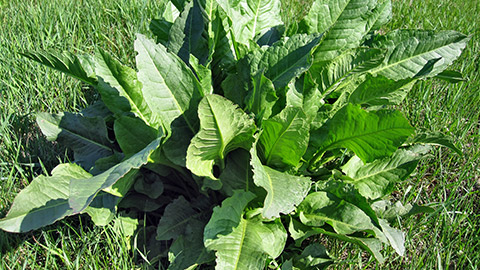
By weeding we mean pulling or digging weeds out of the ground. Ideally, we’ll get the roots and the crow (growing point) out so that they can’t root back into the soil.
We need to get rid of our weeds before they get a chance to seed, to stop the weeds from spreading by reproducing.
In reality, the smaller they are, the better. If you can remove weeds when they are only a few centimetres tall it will be a much easier job. You can weed by hand or use a hoe.
In the case where a weed with a taproot, such as the dock weed in the image above, has been left to grow, you might need to dig it out with a spade.
Edging
While some weeds spread by creating new plants from seed disbursement, others have what is called a spreading habit. This means they actively grow outwards, usually by sending out horizontal root-like structures called rhizomes — which grow below the ground — or stolons (also called runners) — which grow above ground.
To stop these weeds from becoming a problem in your garden beds, cut them back at the edge of the garden bed regularly. You can do this by using a sharp spade, a line trimmer, or a wheel or disc edger such as the one shown in the following product from Mitre10.
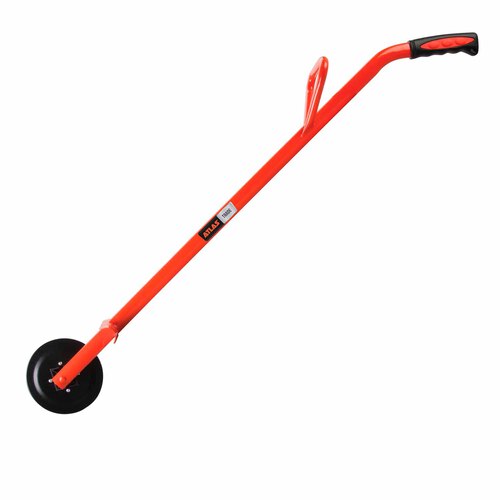
Spraying
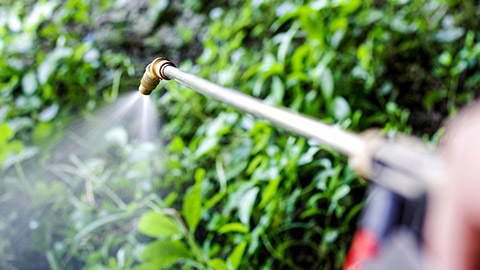
For weeds in garden beds, spraying should be considered the last resort. This is because if the spray gets on the plants we want to keep they will die, or at the very least be damaged by it.
The situation where the spray is blown onto desirable plants is called spraydrift. Despite this problem, spraying can be an effective way of killing weeds over large areas, such as those growing in gravel driveways, or where you want to kill off grass and weeds before turning over a new garden bed.
The most common weed killers (herbicides) in Aotearoa have, as their main ingredient, glyphosate, such as Roundup or G360. It is a synthetic herbicide that kills a wide range of grasses and weeds. Unfortunately, it is also toxic to bees. If you choose to use it, apply it on a day when bees are not active in the area you need to spray.
Other concerns about using synthetic herbicides include:
- Spray residues (from spraydrift) on fruit and vegetables could be ingested (eaten).
- Spray residues may remain in the soil and damage soil organisms.
- Weeds may build up resistance to the active ingredient, meaning that if the same area is sprayed regularly with the same product, over time the plants may no longer die when sprayed.
The research on the effects of synthetic herbicides is ongoing, but from a logical perspective, it doesn’t make sense to use synthetic herbicides on or around our crops if we have other alternatives. And fortunately, we do.
Organic Certified herbicides are made from plant materials and can be used to control a wide range of weeds, clovers, algae, and mosses. You still need to wear the correct safety equipment and take precautions to prevent spraydrift, but these do offer an alternative to synthetic herbicides.
Tip: Always follow the instructions for transport, mixing, applying, and disposal of herbicides.
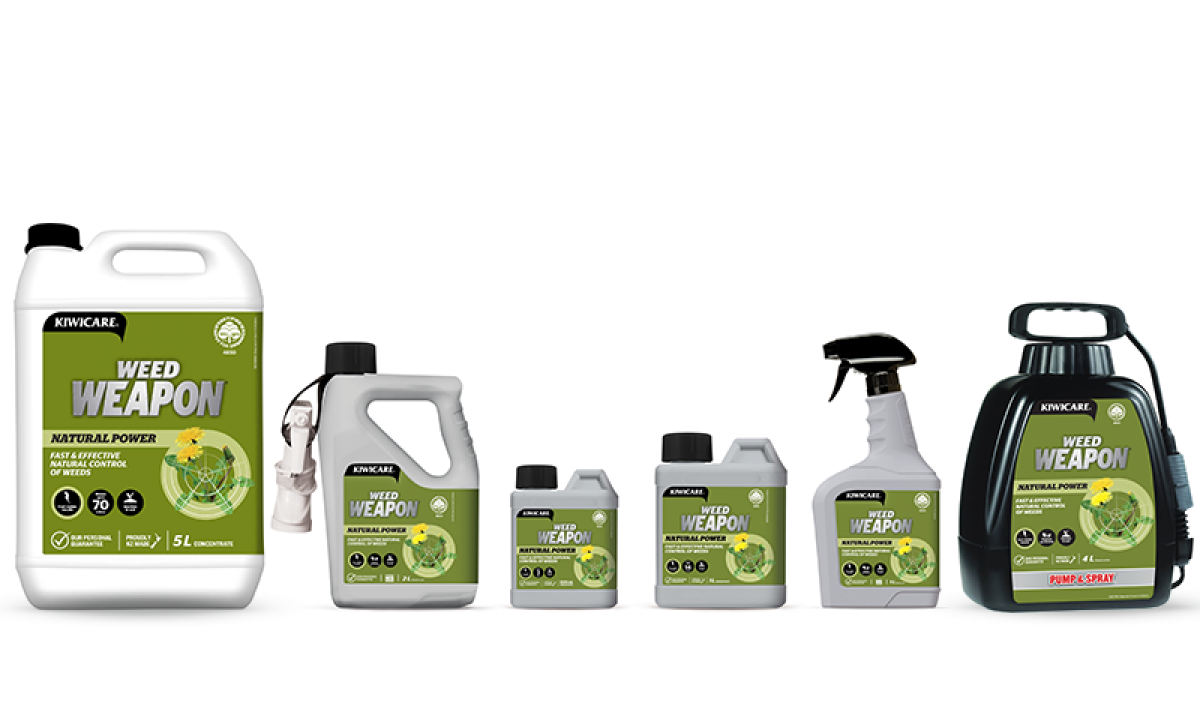
The Weed Weapon Natural Power range, made by Kiwicare, is an example of a Ceritfied Organic herbicide. It is available as a concentrate that you mix with water, or as a ready-to-use spray.
Thinning
Another case of plants becoming weeds is when we choose to plant some plants that we know will turn into weeds.
A great example of this is carrots. Carrot seeds are extremely small and it is common practice to spread carrot seeds into garden beds with the seeds spaced only millimetres apart.
When they start getting larger we need to pull some out to give others the space they need to grow to maturity. And while thinning is a type of weeding, it’s also an important part of looking after our crops.
In the following video from Growfully with Jenna, she demonstrates how to thin carrots.
Activity – Techniques for weed control
